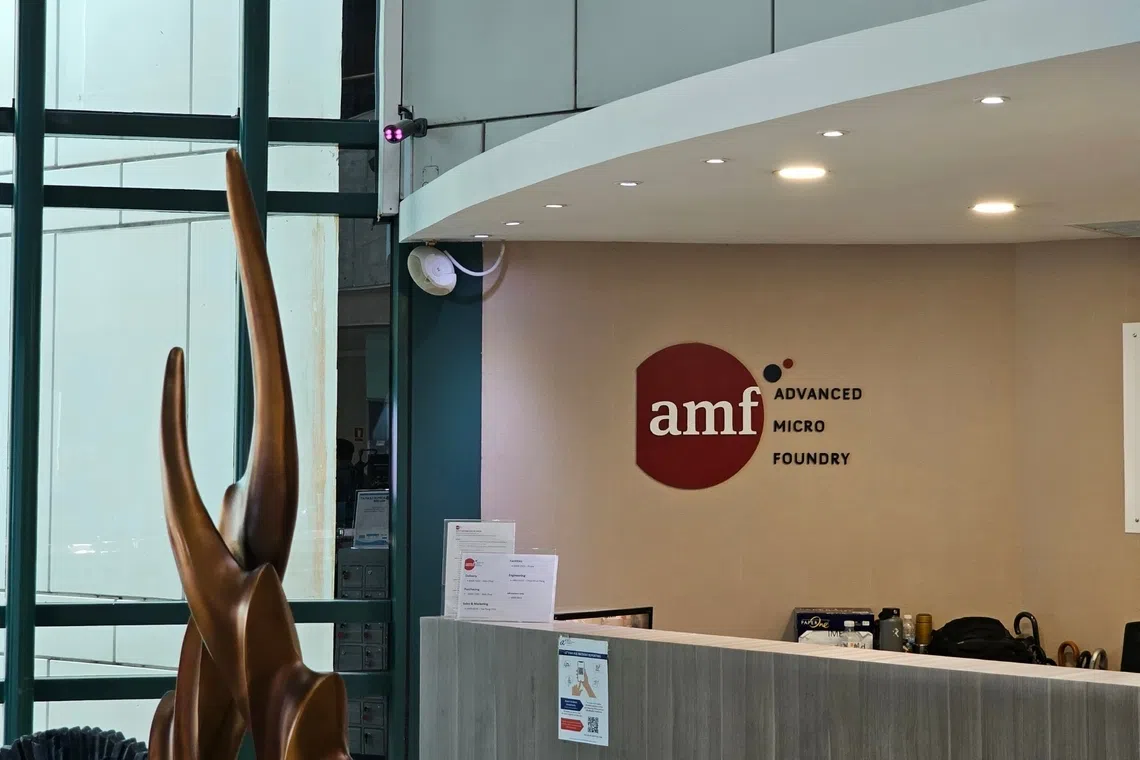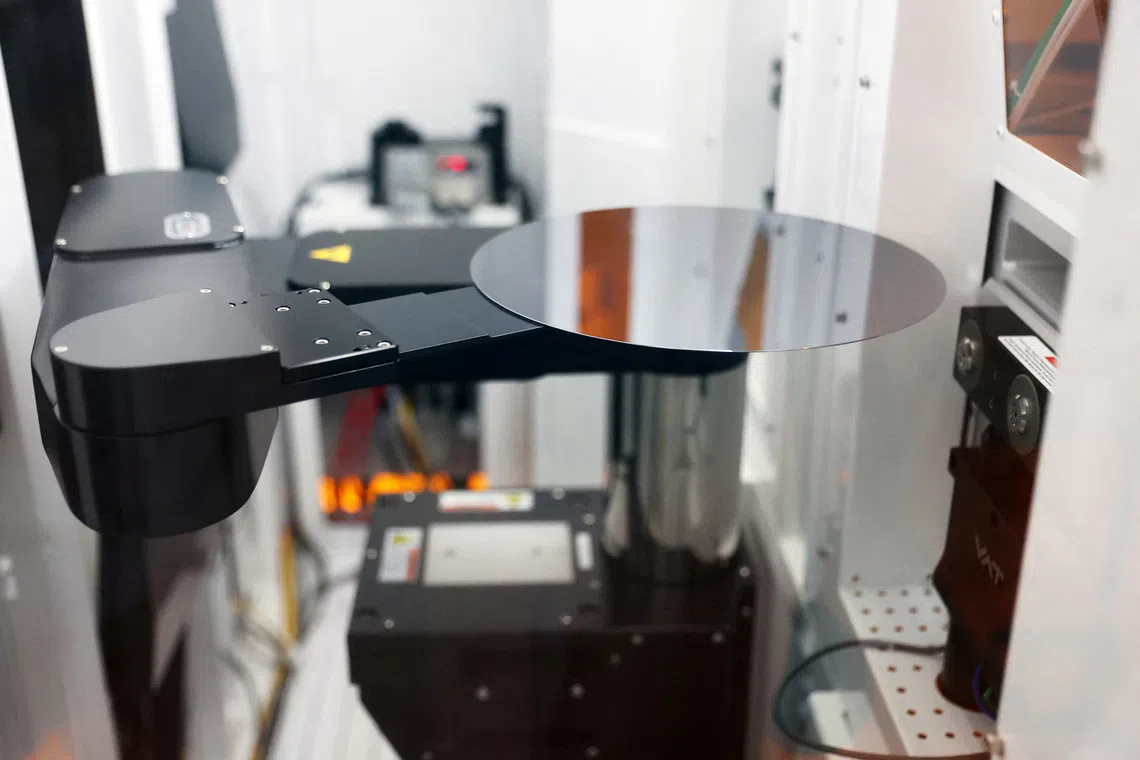GlobalFoundries acquires Singapore semiconductor firm amid AI data centre boom
Sign up now: Get ST's newsletters delivered to your inbox

The move will strengthen Singapore’s position as a trusted, advanced semiconductor manufacturing and innovation hub, and a critical node in the global chip supply chain.
PHOTO: ADVANCED MICRO FOUNDRY
Follow topic:
SINGAPORE - GlobalFoundries (GF), one of the world’s top contract chipmakers, has acquired Singapore’s Advanced Micro Foundry (AMF), in a boost to the Republic’s role in the artificial intelligence-driven data centre and communications boom.
The move will strengthen Singapore’s position as a trusted, advanced semiconductor manufacturing and innovation hub, and a critical node in the global chip supply chain, said A*Star, which spun off AMF in 2017.
It will make GF the world’s largest foundry by revenue for silicon photonics technology.
GF and A*Star – which did not disclose the financial details of the acquisition – also entered into a research partnership agreement to advance silicon photonics technology.
The breakthrough technology integrates optical and electronic components onto a single silicon chip, using light – or photons – instead of electrical signals to achieve ultra-fast and energy-efficient data transfer.
This is critical for handling the massive datasets required by AI applications.
“GF’s acquisition marks the next phase of AMF’s journey, scaling to bring world-class silicon photonics innovations developed in Singapore to global markets,” A*Star said.
The US chip giant plans to establish a silicon photonics research and development centre of excellence in Singapore.
This centre will partner with A*Star to advance GF’s innovation road map by focusing on next-generation materials for ultra-fast data transfer at 400Gbps speed, the company said.
This collaboration will enhance the company’s photonics platform to provide high-performance, secure data transfer solutions to its customers worldwide, GF added.
GF already has an agreement with A*Star to access the research agency’s state-of-the-art R&D facilities, capabilities and technical support in advanced packaging.
AMF, which says it is the world’s first dedicated silicon photonics foundry, has a portfolio of global customers.
Currently, it has about 250 employees, while GF’s Singapore-based workforce numbers 3,800.

GlobalFoundries’ Singapore fabrication plant in 2023.
PHOTO: REUTERS
AMF chief executive Jagadish C.V. said: “With complementary technology portfolios, we are proud to join forces with a trusted manufacturer with global reach, and together, look forward to advancing silicon photonics technology for a broader range of markets and customers.”
Apart from data centres, telecom networks and high-performance computing, photonics chips are also used in sensing devices such as LiDAR (Light Detection and Ranging) systems for autonomous driving and robotics. They are also used in medical imaging and quantum computing.
GF said the acquisition will expand its photonics portfolio, production capacity and R&D in Singapore – complementing its existing technology capabilities in the US and unlocking new market opportunities.
GF chief executive Tim Breen said photonics is essential for AI infrastructure.
“As data moves faster and workloads grow more complex, the ability to move information with greater speed, precision and power efficiency is now fundamental to AI data centres and advanced telecom networks.
“Acquiring AMF enables GF to deliver an expanded, and differentiated, decade-long road map for pluggable transceivers and co-packaged optics, while accelerating growth of photonics into adjacent markets such as automotive and quantum computing.”
GF said the acquisition brings with it AMF’s manufacturing assets, extensive intellectual property and skilled talent.
Leveraging over 15 years of AMF’s manufacturing expertise, GF will address demands in long-haul optical communications, computing, LiDAR and sensing on AMF’s existing platform in Singapore with plans to scale it up as market needs grow.
A*Star said Singapore’s early and sustained investments in photonics, which is now seen as foundational to next-generation AI systems, have established the nation as a critical node in the global semiconductor supply chain.
A*Star’s Institute of Microelectronics (IME) launched Singapore’s silicon photonics R&D programme in 2007.
This was followed by the National Research Foundation’s support in 2015 for the Lux Photonics Consortium.
The Lux consortium aims to foster collaboration among various stakeholders, including industry players, research institutions and academia, to drive the development of the technology in industries.
A*Star IME’s capabilities later seeded the spin-off of AMF, which has since become a key contributor to the global photonics ecosystem, the agency said.
Singapore is investing over $1 billion in semiconductor R&D
Priority areas include photonics, advanced packaging, specialised materials and optics.
A*Star chief executive Beh Kian Teik said the collaboration with GF builds on nearly two decades of national investment and capability development, and reflects strong confidence in Singapore’s translational R&D strengths.
“We look forward to pushing the frontiers of silicon photonics with GF and delivering new economic opportunities for Singapore,” he added.
Mr Jermaine Loy, the managing director of Singapore Economic Development Board (EDB), said: “GlobalFoundries is a key pillar of Singapore’s semiconductor sector, with extensive manufacturing, R&D and regional headquarters operations that create skilled jobs and deepen partnerships with the local ecosystem
“A*Star and EDB have worked closely together to support GF’s next phase of growth in Singapore and strengthen its footprint here.”
Mr Kevin Soukup, who heads GF’s global photonics business, explained in an interview with The Straits Times how the explosive growth of AI is driving the demand for photonics chips and why AMF complements GF’s photonics portfolio.
He said that with the amount of computing power needed increasing by four to five times a year, thanks to increasing AI workloads, data centres are facing both latency – the time it takes for data to travel – and power consumption issues.
“Not only do you need to worry about the processing capability, but you need to worry about the ability to get data to the processors efficiently. And that is really where silicon photonics comes in,” he said.
He said high-end accelerators, such as graphic processing units in data centres, are often sitting idle between 40 per cent and 80 per cent of the time waiting for data that they can process.
Traditionally, data was transferred from networks to data centres, and within data centres, via electrical signals that travel through copper wires.
But the copper infrastructure is unable to handle higher data transfer speeds and consumes too much power.
Light signals travel through optical fibres that are more power efficient and allow faster data transfer.
“Silicon photonics not only allows you to reduce the latency, it allows you to operate at very high bandwidth with a much lower power footprint.”
On the decision to acquire AMF, Mr Soukup said the Singaporean company offered a strong platform in optical telecom networking that GF lacked.
He explained that optical networking is divided into three parts. One is long-haul communications – called scale across – and then mid-range and short-range communications referred to as scale out, and scale up.
“AMF is quite strong in scale across, and GlobalFoundries is really well positioned in the scale out and scale up portion of the network. Hence, AMF was a good fit for GF.”
Mr Soukup added that AMF was also looking to expand, and GF’s large-scale fabrication plants in Singapore offered the opportunity to unlock its growth potential.


